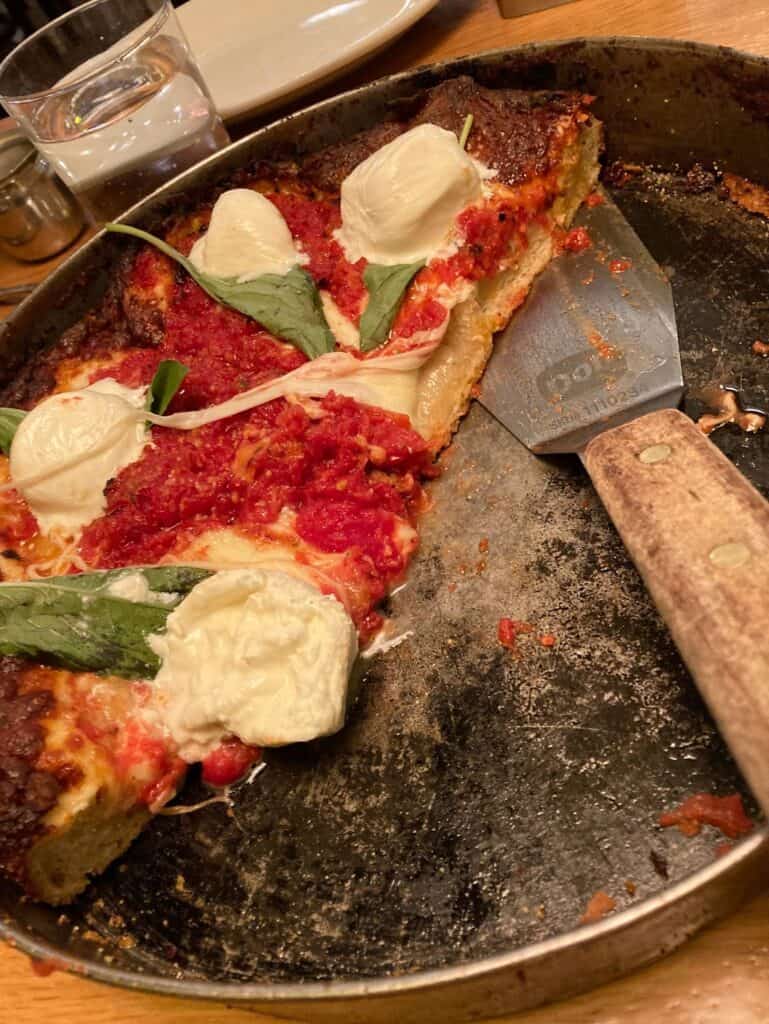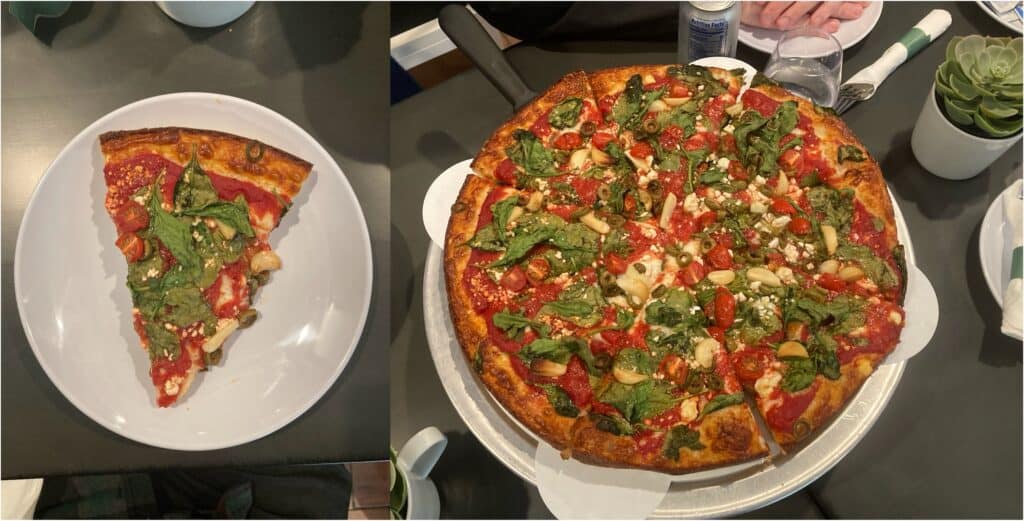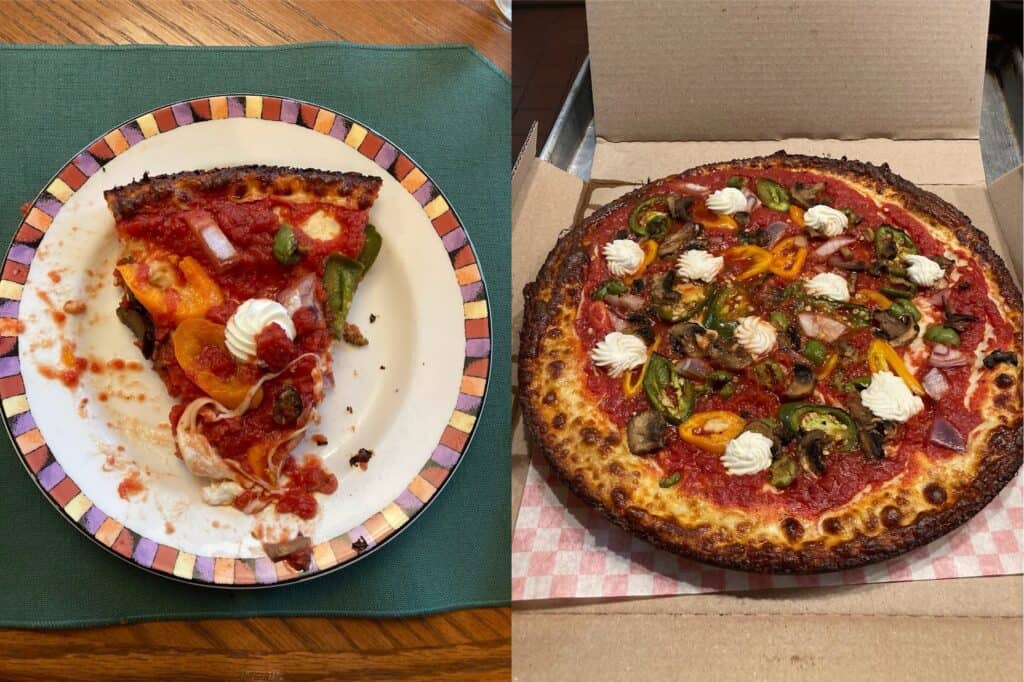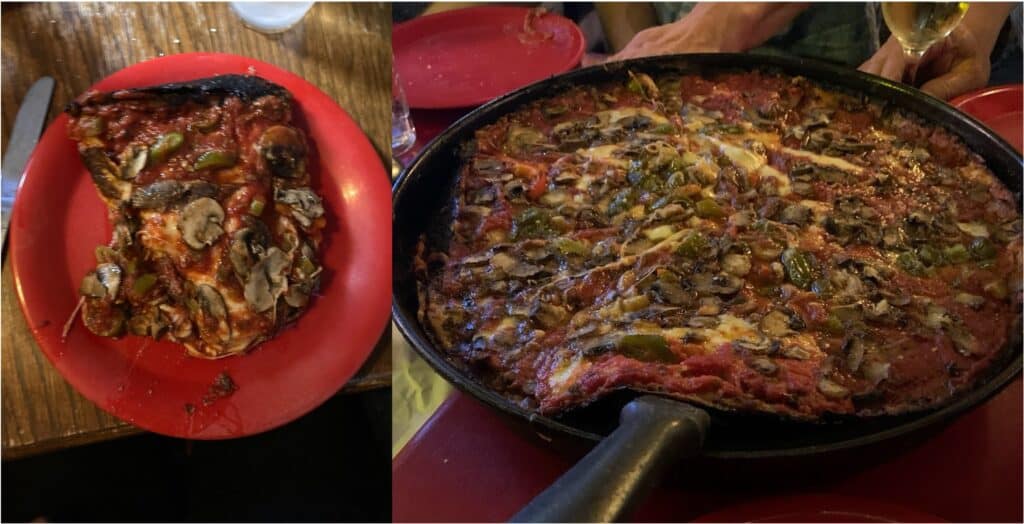This article is the third of a four-part reflection. Get caught up and read the first two parts:
PART 3: THE INNOVATORS
The last article covered the no-nonsense pizza joints that established Chicago deep dish as a nationally recognizable style of pizza. They are traditional, like your parish back home that’s had the same priest and choir your whole life. It’s not the most powerful or memorable experience you’ve had, but you keep coming back for a sense of comfort and familiarity. These next four restaurants build upon the tradition laid down by the last four, opening the doors and letting in the fresh air of the contemporary world to make something innovative and delicious. These are the hip youth pastors of the pizza world, but the ones mature enough to grow and change alongside their parishioners.
Labriola

Jesuits are often referred to as “contemplatives in action.” We sit by ourselves in the stillness of prayer and walk through the joys and challenges of modern life with the people of God. We are spiritual guides and social activists; we are parish priests and astrophysicists; we are at the center of the Church and at the margins of society. Unlike Trappists, wholly committed to a life of contemplation or the Missionaries of Charity,wholly committed to serving the poorest of the poor, we Jesuits have found our strength in balance rather than focus. As Ignatius directs us in the Spiritual Exercises, we are to be “like a balance at equilibrium, without leaning to either side, that [we] might be ready to follow whatever [we] perceive is more for the glory and praise of God our Lord…”
Labriola pizza has achieved Ignatian equilibrium. If pizza has two poles – light, fresh Neapolitan-style on one side and rich, heavy deep-dish on the other – Labriola has found a way to be both/and. Its focaccia crust is both thick and light, both crispy and chewy. Its cheese is both heavy and fresh. Its sauce and toppings are both rich and bright. It has the form of a deep dish and the characteristics of a Neapolitan. Where most deep dish shops lean into the heaviness of the pie by adding deep tomato sauce, mountains of cheese, and generously spiced toppings, Labriola finds the balance point on the scale by making their crust fluffier, sauce brighter, and toppings fresher than anywhere else in town. This makes for a pizza that will leave you contemplating how good it was and inspire you to take action and get another one.
Fluffiness: 10/10
Brightness: 10/10
Freshness: 10/10
Ignatian Balance: 5/10
George’s


Ignatius suggests we begin prayer by asking for the grace we desire. We also hope that our desires align with God’s desires for us. It is almost like a dance, asking to be moved by our partner: we express our desires while asking God to shape those same desires. Our prayer is driven by this dance between grace, desire, and intention: grace shaping our desires, forming our intentions, and asking for more grace.
Naturally, this leads to pizza—George’s in Edgewater. George, its founder, chef, and almost everything else, runs a small, simple shop only a few streets from our Jesuit community. He sold pizza out of his apartment for a few years before opening this restaurant in 2021. His mother runs the till. George’s was the last place we ate in Chicago (and the last of our pizza stops) before leaving for our next missions, so there will always be a piece of our heart left there.
The crust is the most essential part of George’s pie. He drew inspiration from lagana, the Greek flatbreads he associates with spending time in Greece with his father. George modifies the family recipe by using a sourdough fermentation to raise the dough. It makes for a hearty, tangy crust with a solid structure, supporting the toppings without becoming too bready. The sourdough starter takes days to ferment, meaning you have to order the pizza two days in advance. Yes, you read that correctly. George needs to know how many pizzas to make, so you have to tell him on Thursday if you want a pizza on Saturday. It works because it’s worth it. The crust is phenomenal. The adapted family recipe holds the pie together, much in the way the simple, family hospitality from George’s mother keeps drawing you in. She is kind, and the crust is good.
Indeed, you may come just to try the crust, but you stay for the toppings. George’s offers a tight, well-crafted menu of several specific pies, each with a blend of toppings that function harmoniously together. This is where the grace comes in. In the Spiritual Exercises, the foundational experience of Jesuit novitiate, we ask for different graces at different times, following the spiritual movements of the retreat. Perhaps my favorite recurring line in the instructions written by St. Ignatius occurs at the beginning of many prayer sessions: “I ask for what I want, which here shall be…” Ignatius is telling you what you want! For a spirituality known for valuing and expressing one’s desires, telling us what those desires should be seems pretty out of place.
But no. If you’ve been following the meditations and contemplations, letting yourself be shaped by them, you find, sometimes shockingly, that what Ignatius suggests is already what you want, before he has said so, and even if you didn’t expect it. George’s pies are like St. Ignatius’ suggestions for grace. Sure, he’ll let you select your own toppings. But you already want what George put on his menu. If you’ve been following the pizza scene, tracking the movements towards sourdoughs and focaccias, if you’ve opened up to George (and his mom) when he asks you what you like in a pie, and let yourself browse and peruse the menu when you make your reservation, humbly, I ask—trust the movements. Stay on-menu and let George guide and shape your desires, the pizzas you crave. You won’t be disappointed.
So, trust the grace, let it shape you. And please say hello to George’s mom for us.
Sourdough crust: 10/10
Asking for what (George says) you want: 10/10
Family hospitality: 10/10
Leaving Chicago: 0/10
Milly’s

I like birthdays. I had my thirtieth one this year. I asked my friends in the Jesuit community to throw me a 30th birthday party with just one request: order pizza from Milly’s. It was April, and Milly’s was one of the last deep dish places we’d not yet tried before moving away from Chicago. Similar to George’s, Milly’s began as a ghost kitchen and became a brick-and-mortar shop in Edgewater just a few years ago. In Good Morning America’s “United States of Pizza” challenge, Milly’s beat out George’s to win the award for best pizza in Chicago. What better way to kick off a new decade of life than by sharing award-winning deep dish?
With pies bearing such names as “Clickbait,” “Que Suerte,” and “Updog,” Milly’s is known for topping its pizzas with unique combinations of high-quality ingredients. Our veggie pie had castelvetrano olives, red onion, mushrooms, kumato tomatoes, mini sweet peppers & fresh ricotta cheese. Even though the crust (which sports a caramelized cheese edge like Pequod’s), sauce, and cheese were all terrific, the toppings stole the show. They hit all five basic flavors: salty, sweet, bitter, savory, and sour. Like candles atop a birthday cake, they elevate something stable and good to something special and great. Most birthday pizza is served to sweaty children by an even sweatier rat-man surrounded by fake guns and real screaming. It tastes as such. My birthday pizza from Milly’s was playful in its approach and deliberate in its execution, which is appropriate for people in their thirties: still fun, but just dignified enough to be interesting.
Birthdays: 30/30
Basic flavors: 5/5
Approach: 10/10
Execution: 10/10
Pequod’s

As Jesuits, when we pray, we always start in gratitude. Praying like our brother Peter Faber, who quoted Psalm 102 to open his memoirs, we settle into how it feels to remember God’s goodness in our lives, wherever we are—”Bless the Lord, O my Soul, and forget not all his benefits.” When I pray with my time in Chicago, my gratitude almost always brings me straight home to Pequod’s.
Founded in Morton Grove as a hometown pan-pizza place before expanding to N. Clybourn west of Lincoln Park, Pequod’s two locations have ascended to local and national stardom. Its (sort-of) recent spot on FX’s culinary drama The Bear and prominent place on any Chicago “Best of” list makes that clear. The miracle of Pequod’s is that, despite all of that fame and attention, it can still be home, simple and familiar, your own special place for friends and family.
Their pie is mainly known for its signature caramelized cheese crust, a layer of cheese that wraps its way around the vertical edge of the pizza. It’s delicious. It adds just the right crunch and saltiness to the whole. However, the core of the pizza is not the crust. It is the sauce—thick, rich, deep. This is the sauce your mom has had on the stove all day. It’s deep and heavy, savory on its own, but not too much so. It’s also a little under-salted. Therefore, engaging with Pequod’s toppings means that you need to complement the sauce with a savory and salty topping like pepperoni, anchovies, or giardiniera. Crucially, the pie succeeds only at the intersection of the sauce, abundant toppings, and cheesy exterior. You have to learn how to order a pie at Pequod’s—and you can mess it up.
This possibility for error, this space for learning, is vital, because it means you can be formed as the sort of person who knows how to eat at Pequod’s. You can be brought into Pequod’s, taught how to eat, grow in familiarity. If Pequod’s begins to feel like home, it is because it shapes you.
Perhaps my favorite thing about Pequod’s is what some have described as its inconsistency. Every once in a while, some upstart pizza reviewer will slam Pequod’s for having a pie that is too bready or undercooked. This is true. Especially at North Clybourn, when the restaurant gets too busy, the pizza suffers, and you may get a pie that’s good but not great. As such, you begin to learn when to go to Pequod’s—feeling in time the rhythm of the place. It’s like learning when to swing by your friend’s favorite bar, hoping to find them there. (side note: you could usually find me at Pequod’s around 11pm on any night during midterms or finals).
So why does my prayer start with Pequod’s? Simply put, it is because Pequod’s is home. As Jesuits, we live on the move—the world is our monastery, and the road is our home. After several years on the move and, God willing, with many more years to come, Pequod’s was the first public place that felt like home on the road. It’s a home that lets the traveler come in and feel like they’re part of it, even if just for a while. Although I look forward to going home for a full pie someday soon, Pequod’s has me confident that the grace of the road is enough. Thanks be to God.
Home on the Road: 10/10
Saucey slices: 10/10 (8/10 on Fridays)
Learning how to Pequod’s: 5-10/10. You’ll figure it out with time and help.

